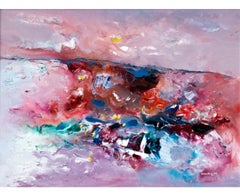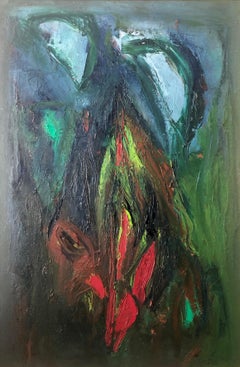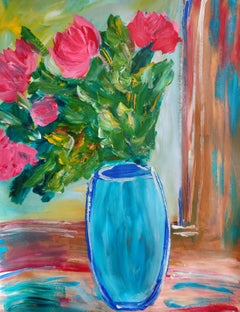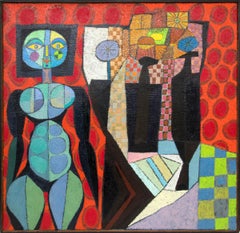Burlap Figurative Paintings
to
1
1
2
Overall Width
to
Overall Height
to
3
2
1
28
4
3
3
2
2
2
3
1
1
1
1,113
2,926
1,640
1,483
1,401
2
3
Style: Abstract
Medium: Burlap
Large Colorful Abstract Expressionist Oil Painting Modernist Beach Landscape
Located in Surfside, FL
Ralph Rosenborg (American, 1913-1992) "American Landscape, Sky and Shore, 1973"
Oil on canvas. Signed 'Rosenborg' (lower right). Titled (verso).
30 x 40 in
Ralph Rosenborg (1913–199...
Category
1960s Abstract Expressionist Burlap Figurative Paintings
Materials
Canvas, Jute, Oil
Large Colorful MCM Abstract Expressionist Oil Painting Modernist Ralph Rosenborg
Located in Surfside, FL
Ralph Rosenborg (American, 1913-1992) Mountain Weed with Two Clouds, oil on jute canvas, canvas is hand signed recto and verso, artists label and Snyder Fine Art gallery label, The p...
Category
1960s Abstract Expressionist Burlap Figurative Paintings
Materials
Canvas, Jute, Oil
Portrait of a Man Drinking Beer in Acrylic on Paper
Located in Soquel, CA
Portrait of a Man Drinking Beer in Acrylic on Paper
Whimsical portrait by Ricardo de Silva (Brazilian, 20th Century). A piece of burlap is applied...
Category
1980s Abstract Impressionist Burlap Figurative Paintings
Materials
Acrylic, Burlap, Paper
$1,480 Sale Price
20% Off
Related Items
Contemporary impressionist expressive floral painting paper "Roses in light"
Located in VÉNISSIEUX, FR
This expressive and vibrant floral painting of roses, created by the contemporary French artist Natalya Mougenot, is a dynamic representation of nature’s energy. Born in Kazakhstan i...
Category
2010s Abstract Impressionist Burlap Figurative Paintings
Materials
Paper, Acrylic
$430 Sale Price
20% Off
H 25.6 in W 19.69 in D 0.04 in
Antique American Abstract Expressionist Vintage Framed New York School Painting
Located in Buffalo, NY
Antique American modernist abstract painting. Oil on canvas, circa 1940. Housed in a vintage frame. Image size, 18L x 24H.
Category
1940s Abstract Expressionist Burlap Figurative Paintings
Materials
Canvas, Oil
$1,036 Sale Price
20% Off
H 25 in W 19 in D 2 in
"My bouquet of summer flowers" ( small acrylic floral painting on paper)
Located in VÉNISSIEUX, FR
This enthralling artwork "My bouquet of summer flowers" is a testament to the expressive potential of impressionistic techniques.
Rendered with bold, dynamic brushstrokes, the pain...
Category
2010s Abstract Impressionist Burlap Figurative Paintings
Materials
Paper, Acrylic
$210 Sale Price
20% Off
H 8.27 in W 5.91 in D 0.04 in
Abstract impressionist nature acrylic on paper "Serenity in the mountains"
Located in VÉNISSIEUX, FR
This contemporary abstract impressionist nature painting, infused with a touch of modernity and expressive flair, is titled "Serenity in the Mountains."
Vibrant and evocative, this ...
Category
2010s Abstract Impressionist Burlap Figurative Paintings
Materials
Paper, Acrylic
$296 Sale Price
48% Off
H 23.39 in W 16.54 in D 0.04 in
Contemporary semi-abstract portrait of women acrylic painting on paper
Located in VÉNISSIEUX, FR
The painting, titled "Two Halves and One Soul", is part of Natalya Mougenot's series dedicated to exploring the theme of women and the unique, supportive connections they share.
Th...
Category
2010s Abstract Impressionist Burlap Figurative Paintings
Materials
Paper, Acrylic
$440 Sale Price
20% Off
H 25.6 in W 19.69 in D 0.04 in
Contemporary semi-abstract portrait of women acrylic painting on paper
Located in VÉNISSIEUX, FR
"Together We Are Unbreakable" by Natalya Mougenot is a captivating abstract piece created with acrylic paints on heavyweight professional paper.
Part of a series dedicated to women,...
Category
2010s Abstract Impressionist Burlap Figurative Paintings
Materials
Paper, Acrylic
$440 Sale Price
20% Off
H 25.6 in W 19.69 in D 0.04 in
Contemporary still-life acrylic painting on paper " Morning coffee with tulips"
Located in VÉNISSIEUX, FR
In her latest series, French artist Natalya Mougenot delivers a vibrant and contemporary interpretation of still life, capturing the fleeting yet profound beauty found in life’s simp...
Category
2010s Abstract Impressionist Burlap Figurative Paintings
Materials
Paper, Acrylic
$430 Sale Price
20% Off
H 25.6 in W 19.69 in D 0.04 in
"Plan Ahead, Winter Is Coming" By Andreas Claussen, Surreal Astronaut Painting
Located in Denver, CO
Andreas Claussen’s **"Plan Ahead, Winter Is Coming"** (2023) is a striking oil painting that blends surrealism and contemporary realism. Measuring **31.50 x 42.20 inches**, this comp...
Category
2010s Abstract Expressionist Burlap Figurative Paintings
Materials
Canvas, Oil
Andreas Claussen"Plan Ahead, Winter Is Coming" By Andreas Claussen, Surreal Astronaut Painting, 2023
$6,300
H 31.5 in W 42.2 in D 1.2 in
Contemporary expressionist still life painting "Bowl of apples and a pear"
Located in VÉNISSIEUX, FR
This contemporary abstract expressionist still life painting, created by French artist Natalya Mougenot, is part of her ongoing still life series that celebrates the beauty of everyd...
Category
2010s Abstract Impressionist Burlap Figurative Paintings
Materials
Paper, Acrylic
$335 Sale Price
20% Off
H 16.54 in W 11.7 in D 0.04 in
Impressionist expressive acrylic painting of a couple "Together in strength"
Located in VÉNISSIEUX, FR
This contemporary expressive figurative piece, titled "Together in strength," was created by French artist Natalya Mougenot and forms part of her intimate series dedicated to the the...
Category
2010s Abstract Impressionist Burlap Figurative Paintings
Materials
Paper, Acrylic
$478 Sale Price
20% Off
H 25.6 in W 19.69 in D 0.04 in
Expressionist impressionist still-life painting on paper "Apples and roses"
Located in VÉNISSIEUX, FR
French contemporary artist Natalya Mougenot invites us into her world of expressive simplicity in "Apples and Roses".
In this radiant acrylic painting, a vase filled with red bloomi...
Category
2010s Abstract Impressionist Burlap Figurative Paintings
Materials
Paper, Acrylic
$430 Sale Price
20% Off
H 25.6 in W 19.69 in D 0.04 in
The Woman Who Smiles Without Reason oil on canvas painting
Located in Sitges, Barcelona
Artist: Nerea Caos
Title: The Woman Who Smiles Without Reason
Year: 2025
Technique: Oil on canvas
Dimensions: 19.7 x 15.7 in (50 x 40 cm)
Framing: Unframed
Style: Abstract Expression...
Category
2010s Abstract Expressionist Burlap Figurative Paintings
Materials
Canvas, Oil
$478 Sale Price
55% Off
H 19.69 in W 15.75 in
Previously Available Items
Large Colorful Abstract Expressionist Oil Painting Modernist Beach Landscape
Located in Surfside, FL
Ralph Rosenborg (American, 1913-1992) "American Landscape, Sky and Shore, 1973"
Oil on canvas. Signed 'Rosenborg' (lower right). Titled (verso).
30 x 40 in
Ralph Rosenborg (1913–1992) was an American artist whose paintings were described as both expressionist and abstract and who was a colleague of the New York Abstract Expressionists in the 1940s and 1950s. Unlike them, however, he preferred to make small works and tended to explicitly draw upon natural forms and figures for his abstract subjects. Called a "highly personal artist," he developed a unique style that was considered to be both mystical and magic. His career was exceptionally long, covering more than 50 years.
Rosenborg was born in Brooklyn, New York, on June 9, 1913. In 1929, while he was a high school student, he began to work with the designer, artist, and instructor, Henriette Reiss. When Rosenborg encountered her, Reiss was serving as an instructor for the School Art League in the American Museum of Natural History. She was then engaged in instructing both students and their teachers in the city school system by a method she called Rhythmic Design. She believed inspiration for abstract designs could be found in rhythms—rhythms that could be perceived in ordinary perceptions much as they are when listening to music. In May 1930 Reiss selected a drawing by Rosenborg to be shown in an exhibition of creative design by City high school students. From 1930 to 1933, aged 17 to 20, Rosenborg studied with Reiss in what Vivien Raynor of the New York Times called a "pupil-apprentice" relationship. During this time she instructed him in music appreciation, literature, and art history as well as giving technical training in art.
In April 1934 Rosenborg was one of 1,500 artists to participate in the annual Salons of America exhibition, which was held that year in Rockefeller Center RCA Building. Each paid two dollars for the privilege of hanging up to three works and none was given prominence over the others. The New York Times reported that by the time the show closed a month later, some 30,000 people had viewed it. The following year he was given a solo exhibition (his first) at the Lounge Gallery of the Eighth Street Playhouse. The year after that he participated in a group show held by the Municipal Art Committee and in 1937 was given a second solo exhibition, this time in the Artists Gallery. That year he also became a founding member of and participated in a group show held by American Abstract Artists, a loose assembly of artists that aimed to promote abstract art and artists in New York. Its founders included Josef Albers, Ilya Bolotowsky, Werner Drewes, Ibram Lassaw, Mercedes Matter, Louis Schanker, Vaclav Vytlacil and Rudolph Weisenborn.
At roughly the same time Rosenborg associated himself with a group of abstractionists that called itself "The Ten" (It included Ben-Zion, Mark Rothko, Adolph Gottlieb and Joe Solman) and in May 1938 joined with its other members in what would be his first appearance in a commercial gallery: the Gallery Georgette Passedoit. In 1938 he his work appeared in a group show at the Lounge Gallery, in 1939 in group shows at the Artists Gallery and at the Bonestell Gallery with David Burliuk, Earl Kerkam, Karl Knaths and Jean Liberte...
Category
1960s Abstract Expressionist Burlap Figurative Paintings
Materials
Canvas, Oil, Jute
Witch with Still Life, Abstract, Cubist Painting, Red, Blue Black, Orange, Green
Located in Denver, CO
Witch with Still Life, vintage oil painting with a semi-abstract, cubist, female figure with an interior still life by Denver artist, Edward Marecak (1919-1993), mid-century modern s...
Category
1960s Abstract Geometric Burlap Figurative Paintings
Materials
Burlap, Oil
H 36.75 in W 36.5 in D 1.25 in
Zeus and Hera, 1967 Framed Semi-Abstract Figural Painting, Mid Century Modern
Located in Denver, CO
Zeus and Hera, abstract realism painting with two nude figures set in a stylized interior by 20th century Denver modernist, Edward Marecak (1919-1993). Painted in colors of orange, b...
Category
1960s Abstract Burlap Figurative Paintings
Materials
Burlap, Oil
H 34.5 in W 46.5 in D 1.75 in
Large Colorful MCM Abstract Expressionist Oil Painting Modernist Ralph Rosenborg
Located in Surfside, FL
Ralph Rosenborg (American, 1913-1992) Mountain Weed with Two Clouds, oil on jute canvas, canvas is hand signed recto and verso, artists label and Snyder Fine Art gallery label, The painting is dated 1965.
Dimensions: 24 x 36 canvas, framed size is 44.5 x 32.5.
Ralph Rosenborg (1913–1992) was an American artist whose paintings were described as both expressionist and abstract and who was a colleague of the New York Abstract Expressionists in the 1940s and 1950s. Unlike them, however, he preferred to make small works and tended to explicitly draw upon natural forms and figures for his abstract subjects. Called a "highly personal artist," he developed a unique style that was considered to be both mystical and magic. His career was exceptionally long, covering more than 50 years.
Rosenborg was born in Brooklyn, New York, on June 9, 1913. In 1929, while he was a high school student, he began to work with the designer, artist, and instructor, Henriette Reiss. When Rosenborg encountered her, Reiss was serving as an instructor for the School Art League in the American Museum of Natural History. She was then engaged in instructing both students and their teachers in the city school system by a method she called Rhythmic Design. She believed inspiration for abstract designs could be found in rhythms—rhythms that could be perceived in ordinary perceptions much as they are when listening to music. In May 1930 Reiss selected a drawing by Rosenborg to be shown in an exhibition of creative design by City high school students. From 1930 to 1933, aged 17 to 20, Rosenborg studied with Reiss in what Vivien Raynor of the New York Times called a "pupil-apprentice" relationship. During this time she instructed him in music appreciation, literature, and art history as well as giving technical training in art.
In April 1934 Rosenborg was one of 1,500 artists to participate in the annual Salons of America exhibition, which was held that year in Rockefeller Center RCA Building. Each paid two dollars for the privilege of hanging up to three works and none was given prominence over the others. The New York Times reported that by the time the show closed a month later, some 30,000 people had viewed it. The following year he was given a solo exhibition (his first) at the Lounge Gallery of the Eighth Street Playhouse. The year after that he participated in a group show held by the Municipal Art Committee and in 1937 was given a second solo exhibition, this time in the Artists Gallery. That year he also became a founding member of and participated in a group show held by American Abstract Artists, a loose assembly of artists that aimed to promote abstract art and artists in New York. Its founders included Josef Albers, Ilya Bolotowsky, Werner Drewes, Ibram Lassaw, Mercedes Matter, Louis Schanker, Vaclav Vytlacil and Rudolph Weisenborn.
At roughly the same time Rosenborg associated himself with a group of abstractionists that called itself "The Ten" (It included Ben-Zion, Mark Rothko, Adolph Gottlieb and Joe Solman) and in May 1938 joined with its other members in what would be his first appearance in a commercial gallery: the Gallery Georgette Passedoit. In 1938 he his work appeared in a group show at the Lounge Gallery, in 1939 in group shows at the Artists Gallery and at the Bonestell Gallery with David Burliuk, Earl Kerkam, Karl Knaths and Jean Liberte...
Category
1960s Abstract Expressionist Burlap Figurative Paintings
Materials
Jute, Oil, Canvas
Downtown Afternoon
Located in Soquel, CA
Downtown Afternoon is a mixed media abstract expressionist figurative abstract with patches of burlap on canvas by an unknown artist. Presented in a rustic giltwood frame. Unsigned. ...
Category
1970s Abstract Expressionist Burlap Figurative Paintings
Materials
Canvas, Burlap, Oil
Burlap figurative paintings for sale on 1stDibs.
Find a wide variety of authentic Burlap figurative paintings available on 1stDibs. While artists have worked in this medium across a range of time periods, art made with this material during the 21st Century is especially popular. If you’re looking to add figurative paintings created with this material to introduce a provocative pop of color and texture to an otherwise neutral space in your home, the works available on 1stDibs include elements of purple, blue, red and other colors. There are many well-known artists whose body of work includes ceramic sculptures. Popular artists on 1stDibs associated with pieces like this include Ernesto Gutierrez (b.1941), Jose Maria de Servin, Peter Hoffer, and Edward Marecak. Frequently made by artists working in the Contemporary, Abstract, all of these pieces for sale are unique and many will draw the attention of guests in your home. Not every interior allows for large Burlap figurative paintings, so small editions measuring 0.1 inches across are also available






